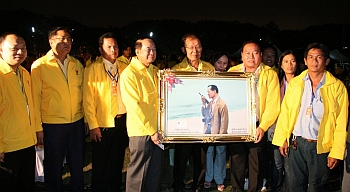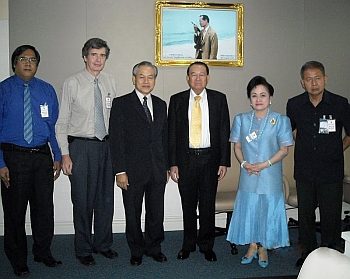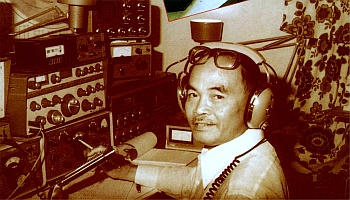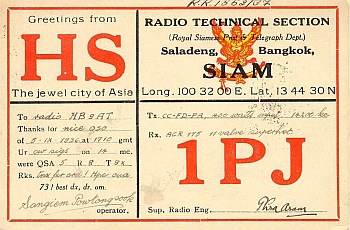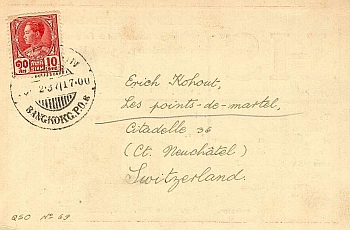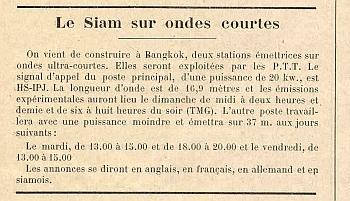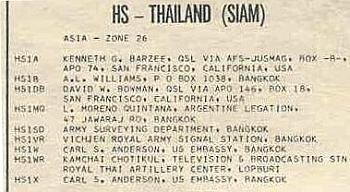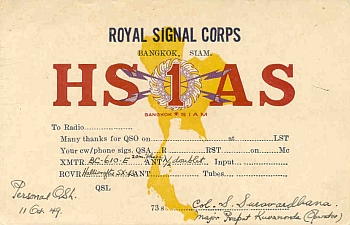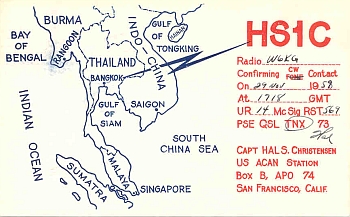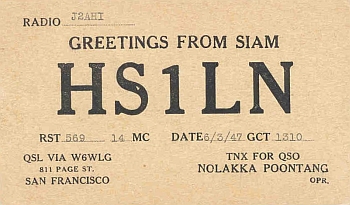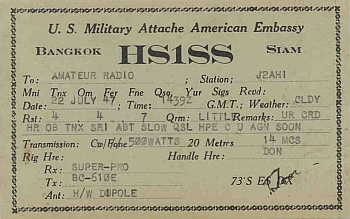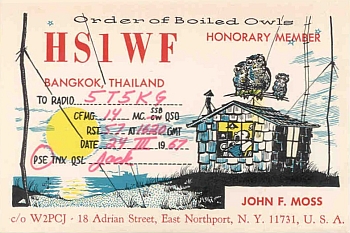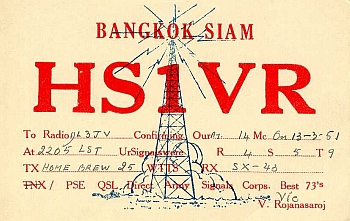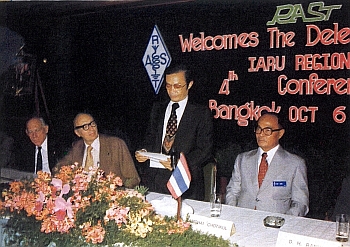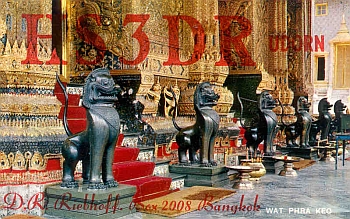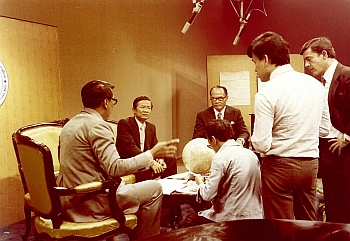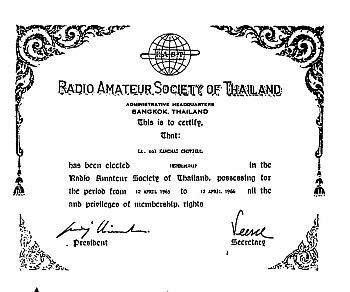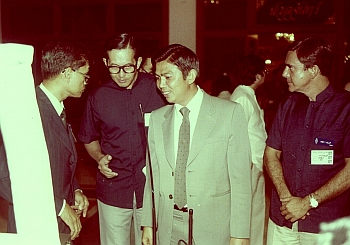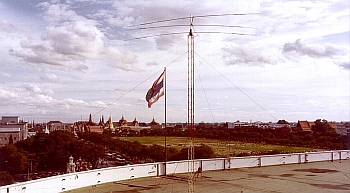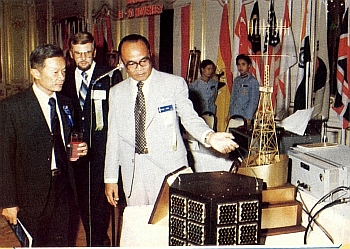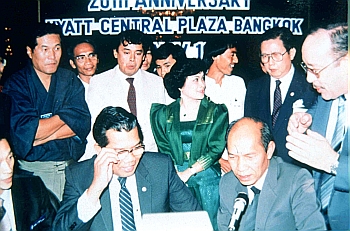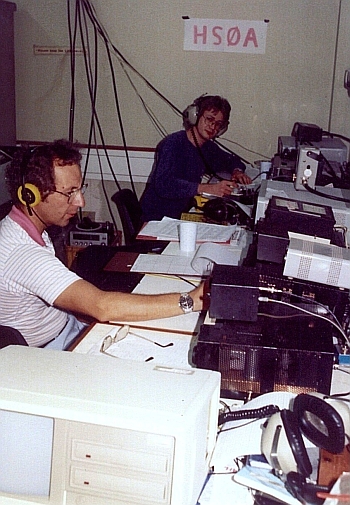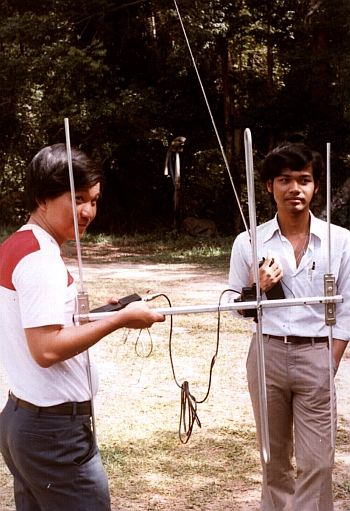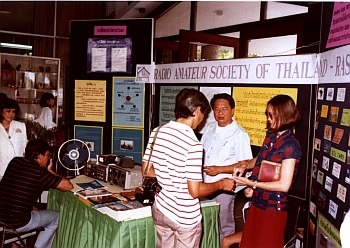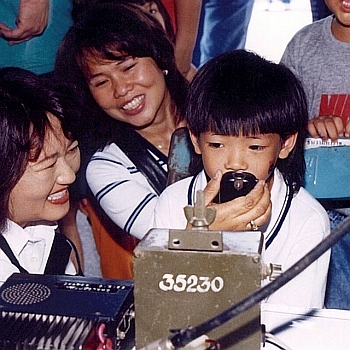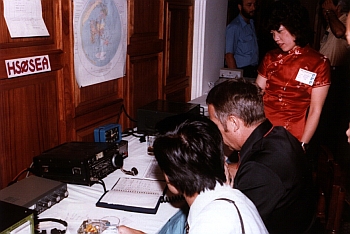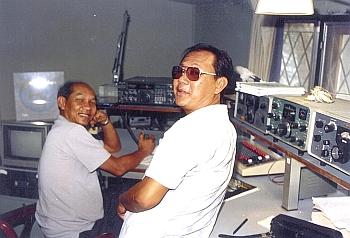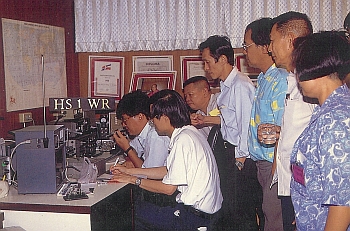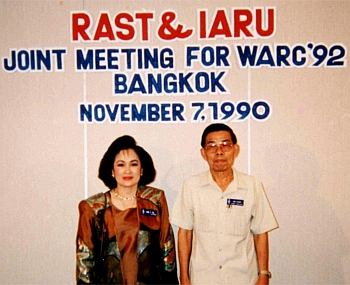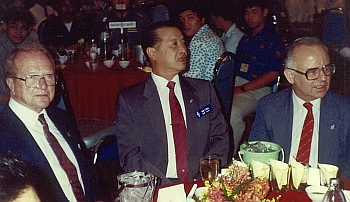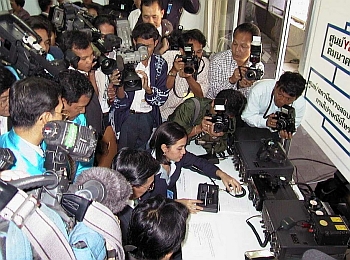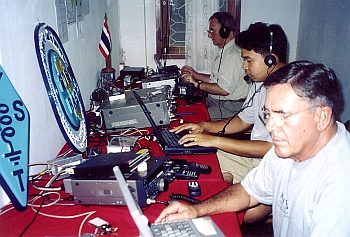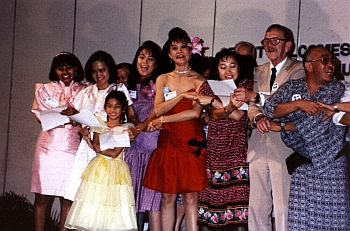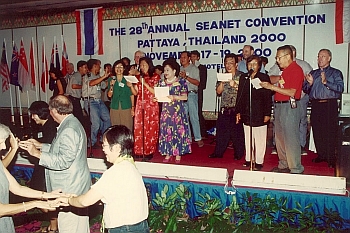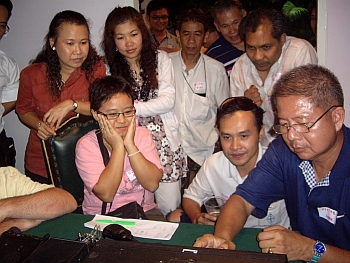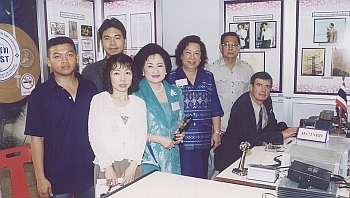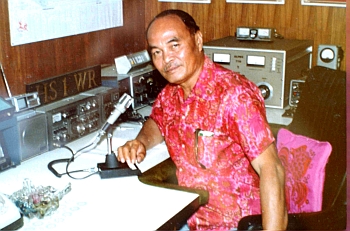Amateur radio has a long history in Thailand
by Tony Waltham, HS0ZDX
The history of the Radio Amateur Society of Thailand under the Patronage of His Majesty the King (RAST) dates back more than 50 years and can be distilled into two distinct eras.
The first 23 years (1964 - 1987) were a struggle grounded in its members' sincere belief in the merits of the hobby of amateur radio and in their determination to practice it as and when they could to demonstrate the benefits -- and, of course, to enjoy the experimentation and the on-air operating aspects.
But in those days most of the efforts of RAST's officers were conducted behind the scenes as they worked for the acceptance and the ultimate legalisation of the hobby.
This was achieved -- with spectacular success -- in late 1987 and the second phase began in January 1988 following the enactment of amateur radio regulations.
Suddenly, an activity that until then had arguably been pursued by only a privileged few -- those who had been exposed to amateur radio abroad or those with high-level connections -- became accessible to any Thai who was interested and who cared to study for and pass the technical exam.
Amateur radio activity then exploded in Thailand and so RAST went into "activity mode".
But let's look back further. International amateur radio activities in Thailand date back more than 85 years, as the 1927 International Radio Amateur Callbook illustrates by listing two amateur radio stations based in Thailand, when the country was called Siam.
These stations were HS1BK at the Royal Siamese Navy Experimental Station and HS1HH, assigned to the Radio Section of the Siamese Post Office and both had addresses in Bangkok.
Other records of amateur radio activity in HS going back over the years include old QSL cards which confirm QSOs of long ago and copies of correspondence between radio amateurs in Thailand and the authorities here.
Radio Amateur Society of Thailand records include a QSL card for a "nice QSO" some 80 years ago between Sangiem Powtongsook, operating HS1PJ, and Swiss station HB9AT which delivered a 589 signal to HS1PJ's 11-valve ACR-175 superhet receiver in 1936.
Some 27 years after that contact, Sangiem was to become one of the co-founders of the Radio Amateur Society of Thailand (RAST), and be the society's first president, according to a document in RAST's hands entitled "Proceeding of the Society," dated August 26, 1963.
This QSL card, which confirms a QSO on 14.2 MHz that took place at 17.10 GMT on September 5, 1936, is clear evidence of how Thai nationals were pioneering amateur radio communications here a long time before the establishment of any formal amateur radio society in the country or even before there were any regulations to allow for the activity.
In most countries amateur radio experimentation predated government legislation
It was such activities by early radio experimenters around the world that eventually led to all progressive governments recognising amateur radio as a productive pursuit and allowing for it in their radio communications legislation. And Thailand has been no exception here.
Thailand's Radio and Broadcasting Act of 1955 specifically provided for amateur radio communications, although the act stopped short of providing the framework or specific regulations to govern its practice, a stumbling block that successive waves of early amateur radio enthusiasts in Thailand were to come up against over the years.
Over several decades, Thai radio hams and foreign amateurs who were resident in Thailand had lobbied successive governments in Bangkok to formally recognise the hobby. But until the mid-1980s their overtures would mostly be met with quiet denials, under one pretext or another.
During the late 1960s and 1970s, the war in nearby Vietnam and Thailand's other neighbours to the east was escalating while communist terrorist attacks in several remote areas within the country were also increasing and the potential threat to national security had generally been cited as the reason for not legalising the activity.
Personal radio communications capabilities were perceived as potentially subversive, although, over the years, Thailand's authorities responsible for security and frequency administration had permitted and monitored limited -but unauthorised - operations by radio amateur enthusiasts based there.
After the Radio Amateur Society of Thailand had been founded, one of its first major duties had been to assign callsigns to those members that its committee deemed were technically-proficient and responsible enough to operate. For non-Thai members, an amateur radio licence issued in the would-be operator's own country was a prerequisite.
RAST laid down the operating procedures, reminding everyone at each monthly meeting, and for transmitting members in particular, that "no politics, no religion and no business" could be discussed on the ham bands.
There was also self-policing within the fraternity of HS-operators, with each of them knowing that if one of their members did not respect these internationally-accepted operating procedures, then everyone's ability to get on the air could be in jeopardy.
Such was the situation during the 1950s, the 60s, the 70s and also for part of the 80s - and RAST's collection of old QSL cards and callbook documentation attests to continued operations and activities throughout this period.
The 1962 international callbook lists nine stations in Thailand
Col Kamchai (Kam) became RAST's first vice president after he, Sangiem and four others helped set up RAST as charter members at a fateful meeting on August 22, 1963 at 7 p.m. at the now-defunct Kawachiya Restaurant.
Among the many subjects discussed at this meeting were: "amateur radio activity in the past, prior licensing in Thailand, the official attitude toward an amateur service, Thailand's recorded objection to international communications with amateurs of other countries, action needed to foster amateur activity in Thailand and the logical approach to the solution of the many problems now existing."
It was unanimously agreed during the meeting that the first critical item of business on the agenda would be to form an organisation for amateurs bearing the name "The Radio Amateur Society of Thailand," this name being adopted from several submitted for study.
Those six charter members were: Mr Sangiem Powtongsook, HS1PJ, of the Engineering Division of the GPO, as president; Col Kamchai Chotikul, HS1WR-SK, of the Royal Thai Army Artillery Centre in Lopburi, as first vice president; Mr Robert Leo, W7LR, of Stanford Research Institute, as second vice president; Mr Frank Phillips, W5QPH, of Stanford Research Institute, as secretary; Mr Jonas Eddy, HS1SD, of G. Simon Radio, as treasurer; and Capt Kenneth Irish of the US Army Signal Corps, as QSL manager.
Following this meeting, these co-founders proceeded to register the intention to establish such a society with the Ministry of Education on November 27 that year, receiving the registration certificate on August 5, 1964, which they followed up by registering with the Police Department and security authorities in September and November that year, respectively.
Later, during the mid-1960s, the Radio Amateur Society of Thailand changed its name for a while, shuffling the acronym. RAST became STAR, which stood for "Society of Thai Amateur Radio" -- although this name was changed back to RAST a few years later.
One of the first tasks facing the newly-formed society was to try to get Thailand removed from the banned list of the International Telecommunications Union (ITU) and the International Amateur Radio Union (IARU). This was a stigma that meant that hams from some countries, including the United States, were not allowed to contact their counterparts in Thailand.
Other pressing issues at that time, recalls Fred Laun, K3ZO, who had arrived in Thailand in mid-1968 for his first stint of foreign duty here, were the signing of a reciprocal agreement between the US and Thailand and the complete legalisation of amateur radio by the Thai Government.
In a memorandum to RAST, Fred Laun recounts how, more than 30 years ago, he set about tackling the issue of Thailand being on the ITU banned list along with then-president Lt Chankij Boonyaratvej, HS1CB, and the society's secretary Don Riebhoff, HS3DR/K7CBZ, who was based in Udon Thani in northeast Thailand.
K3ZO recalls: "We engaged in extensive conversation with Dick Baldwin, W1RU, then assistant secretary of the ARRL (later to become president of IARU) and Ted Robinson, F8RU of the ITU in order to find out why Thailand was on the ITU banned list.
"One of the American members of STAR (as it was called at that time) Bob Daniel, HS1BD/W6LCB, had close relations with Sribhumi Sukhanetr, then the deputy director-general of PTD, who advised that Thailand had not asked the ITU to place it on the amateur radio banned list.
"Ted Robinson sent us a copy of the document which the ITU said was the reason for Thailand's being placed on the banned list. It was a questionnaire about radio in general, written in French, with one question about amateur radio among some 50 total questions," according to K3ZO.
"The question asked: 'Does your administration prohibit amateur radio stations in your country from communicating with those of other countries?' and whoever had answered the questionnaire on the part of the Thai PTD had answered 'yes'.
In 1969, the ITU announced that Thailand had been removed from the banned list
K3ZO, who had been based in Chiang Mai in the north of the country from July 1968 until 1971, also recalled how RAST - then still operating as "STAR" - had applied to become an IARU member society, and about this he writes: "Don Riebhoff and I decided that it would be a good thing to get STAR into the IARU in order to give amateur radio activities in Thailand some recognition, albeit informal, and to give STAR some prestige within Thailand.
"To that end, we invited Michael Owen, VK3KI (now a silent key), then an official of IARU Region III, to visit Thailand, where we gave him an extensive briefing on ham radio here, including a written explanation for the special problems of amateur radio here.
"Not long after he returned to Australia with the STAR application for membership in IARU Region III, the application was approved. This would have been in about 1969," according to K3ZO.
He goes on to note that in 1971 that Col Kamchai Chotikul, HS1WR-SK, assumed the presidency of STAR and that shortly after this, Jonas Eddy, HS1SD, attended a meeting of STAR where he said that the name of the society should be changed back to RAST, since the name STAR had never been properly registered with the Thai authorities.
He adds that the membership voted to do this, and a letter to the IARU explaining the situation resulted in the IARU agreeing to recognise RAST as the new official name of the national society representing Thailand - and this has been the framework under which the society has operated since then.
When Fred, K3ZO, first arrived in Thailand for his Chiang Mai posting with the United States Information Service in 1968 he had been assigned the callsign HS3AL, although this would later be changed to HS5ABD, (or HS1ABD when he later operated in Bangkok), while today Fred Laun's Thai callsign under the bilateral reciprocal agreement is HS0ZAR.
His account of how HS callsigns were changed around 40 years ago to cope with changing circumstances provides an interesting insight into the amateur radio activities in Thailand then: "Towards the end of 1969, with Thailand having been removed from the banned list, there was increasing activity among the US forces here, including a number of instances of bootlegging and traffic handling.
"In order to get things under control, Don Riebhoff and I talked Chankij (HS1CB) into changing the call letter assignment system for hams in Thailand, so that farangs (expatriates) would be issued suffixes with an "A" for the first letter and two more letters, in regular alphabetical order.
"This would make it more difficult for bootlegging, since people in our armed forces could no longer simply choose a callsign with their initials and go on the air. The assignment for farangs, in other words, would be in a regular sequence, and not have anything to do with the name of the operator," K3ZO noted.
"Thais, on the other hand, would continue to have their calls issued under the old system, with two-letter suffixes. Around Christmas time in 1969, Don Riebhoff, Chankij and myself sat in the coffee shop of the Montien Hotel and pulled names of all the farang (expatriate) members out of a hat, starting with "ABA" as the suffix, and on January 1, 1970, the farang members started using these new calls.
"Calls starting with "AAA'" to "AAZ" were not issued since there was a desire to avoid confusion with Khun Suradej, HS1AA (a senior official in the Ministry of Education, Suradej Visetsurakarn, who now holds the callsign HS1HJA)," said Fred, adding: "At the same time, we also changed the callsign numbering system so that there were nine call areas in Thailand instead of four, with the "0" reserved for club stations. This new call area system was designed to make more prefixes available for prefix hunters... based on the nine police districts in Thailand."
Fred also recounted an exchange between his superior here at the United States Information Service and Thailand's then-minister of communications that indicates how the Thai authorities viewed amateur radio operations here in late 1969: "Regarding the efforts to get a reciprocal operating agreement between the US and Thailand, the standard US text for such an agreement was passed to Khun Sribhumi (then director-general of the PTD), who approved it without change. But his highest boss, Gen Dawee (Chullasap), then the communications minister, refused to approve the signing of such an agreement.
'We know that your people are operating, and nobody has bothered them, have they?'
"As for the licensing of Thais, there was no prospect for this at all at that time," K3ZO added.
Nor would this become possible for another 18 years or so.
Successive teams of RAST officers all hoped for and had worked towards the day that amateur radio would be legal in Thailand, as it was in most other countries, so that the country would realise the benefits that the hobby brings in stimulating technically-minded youths to embark on communications-related careers, to conduct experimentation and to gain technical expertise.
For the first 25 years of the society's existence, RAST committee members were frequently engaged in personally lobbying officials at various levels in the government while maintaining international relations through the society's IARU membership.
These activities included engaging in and hosting high-profile international events, including staging the Region III Conference in Bangkok in 1978, an event that is only held once every three years and which confers considerable prestige on the host country.
RAST has also been host to the annual Southeast Asia Network Convention (SEANET) on nine occasions and which has been attended by over 100 visiting foreign delegates on each occasion, while many of its members participated in the first regional gathering in Penang in 1971.
Other promotional activities included a special Thai TV Channel 4 programme in the early 1970s when Sribhumi Sukanetr, then PTD director-general, discussed amateur radio operations here with senior RAST officials. RAST's representatives included Kamchai, HS1WR-SK, Eddy Campos-Tortosa, HS0/EA4BKA-SK, Chaiyong Wongwuticomjon, HS1BL (now HS1QVD) and who later became a President of RAST, and Fred Laun, K3ZO.
Indeed, later this year RAST will host the 44th SEANET Convention again in Pattaya, a beach resort on the Gulf of Thailand which will be the tenth time it will have hosted this international event.
Senior government officials also routinely graced RAST events, such as when the then-minister of communications Samak Sundaravej, who later become the governor of Bangkok and who was Prime Minister for several months in 2008, presided over RAST's 20th anniversary celebrations, giving an inspiring speech about the benefits of amateur radio.
Meanwhile, RAST's on-air activities would keep reminding Thai authorities of the presence of a global community of radio amateurs that its members were constantly getting in touch with.
RAST's club and special event stations were particularly active during a period when HF home station operations were forbidden from December 31, 1982 until the time when legal ham radio operations from licensed operators on the short-wave bands could begin in January 1988.
During this five-year "silent" period, RAST formally applied to operate in all the major international radio contests such as the CQ WorldWide DX and WPX contests, the All-Asia DX and SEANET contests. These were conducted from the society's main club station at the Asian Institute of Technology, first using the callsign HS0A, and later HS0AC, as well as from another club station established at the Science Museum in downtown Bangkok.
In addition, when an exhibition provided RAST with an opportunity to propose that a ham radio station be set up, the society would often provide and operate a demonstration station.
One such station was when the society's members set up and operated a special event station from the Science Museum near Soi Ekamai on Bangkok's Sukhumvit Road during the National Communications Day exhibition in August 1986.
This activity continued for successive years, while a special event station was also set up at the Science Museum in April 1987 for a 10-day period during an exhibition to mark the Ministry of Transport and Communications 75th anniversary.
The establishment of this station marked the beginning of a good relationship between RAST committee members and the museum's authorities, who saw the benefits of a demonstration station and the interest that it generated. This would later lead to the establishment of a club station there.
All these activities helped to raise the profile of amateur radio, nudging the process of fully legalising the hobby along, winning the support of many senior officials in the PTD.
A PTD report indicates that between 1969 and 1983 the department, with the encouragement of RAST, had made repeated appeals to the Ministry of Communications, the National Frequency Management Committee and to the National Security Council (NSC) to legalise amateur radio.
But it noted that in each case the final response had been to reject or defer the request on the grounds that the PTD was not yet capable of properly monitoring or administering the activity, or that amateur radio posed a threat to national security, or even that it simply was not an "appropriate" activity for Thailand.
The 1980s would turn out to be a turbulent decade for amateur radio in Thailand
This was also a difficult period to navigate at times for RAST members and for the society's officers, particularly after the establishment of so-called "Voluntary Radio" operations by the PTD in late 1981. This permitted channelised two-metre operation, but broke with international convention regarding the use of callsigns.
This bold move by PTD director-general, the late Suchart P. Sakol (HS1BA-SK), had been announced on December 5, 1981 and is now seen as pushing amateur radio to the point of no return, although he had put his career on the line to achieve this - and, at the time, this move won him no friends at RAST.
Earlier that year, the PTD had asked all owners of amateur radio equipment to bring their unregistered (and hence illegal) transceivers to the department so that a serial number could be issued, along with a license to possess it. To this end, RAST organised "baptism'" parties to which its members brought their radios and where officials would etch a serial number and then issue the documentation.
In all, some 800 transceivers were registered in this way, according to figures published by the PTD, which estimated that in September 1981 there were some 800 amateur radio operators in Thailand.
That year, the PTD had again appealed to the National Security Council (NSC) to permit amateur radio operations, but no official response had been received. However, in September 1982 the department and the NSC met again when the PTD was asked to demonstrate its capability to enforce the regulations in the Radio Communications Act of 1955 - and the Post and Telegraph Department would again fail to satisfy the national security agency.
"Voluntary radio," which was more or less amateur radio by another name, enabled licensed operators to use the 144-146 MHz band and callsigns were issued with the initials "VR" followed by a serial number. This was a move that, along with using a different name, succeeded in side-stepping the legislative issues associated with full amateur radio according to the Radio Communications Act of 1955.
In addition to a VR+number callsign, operators were also issued with an HS callsign, although the practice encouraged in the early 1980s was for operators to use their VR-calls. Naturally, this introduced rivalry between RAST members, who had previously been operating on two metres with HS-callsigns, and the new "VRs" as they were called.
Further "rubbing things in" was the fact that in many instances, these new HS-calls issued to the VR-operators had been previously used by RAST members, both on HF and on VHF, although some Thai RAST members were able to preserve their callsigns by sitting and passing the examination necessary for a VR call. To its credit, the PTD did try to respect the RAST-issued HS calls whenever they could and the PTD liaised with RAST about this.
VHF-only VR licences became very popular in Thailand in the days before mobile phones
To support this activity a new radio club called the Voluntary Radio Association (VRA) was established to cater to this new band of VHF operators, making 1982 an uneasy year for RAST, which saw its authority and previous status as the issuer of HS callsigns eroded by these "voluntary radio" operations.
During 1982, RAST continued its activities, its members still being able to operate their HF stations from their homes with their newly-registered HF equipment, while most Thai members sat and passed the new VHF examination for a voluntary radio licence and so were able to continue operating on two metres.
But 1982 was made much gloomier for the society when RAST president Kamchai, HS1WR-SK, who had been running the society since gaining the presidency in 1971, suddenly became very ill during preparations for a forthcoming SEANET convention in Bangkok.
With the convention just weeks away, Kam, as he was known to his friends and RAST members, was admitted to Chulalongkorn Hospital where he was diagnosed with cancer. Sadly, he did not live long enough to welcome the SEANET delegates that November, but he did make a death bed wish to his wife, Mayuree, HS1YL, as well as to the late Hans Hollstein, HS0/KA3TDZ-SK and myself - and one that I remember to this day.
That request was for us each to do our best to promote amateur radio in Thailand after he was gone. This was an appeal that I shall never forget from the man appropriately dubbed "the father of amateur radio in Thailand."
Nor did Hans Hollstein forget this and, as QSL manager and as a RAST officer, Hans always did his best to help and inspire young Thais to take up the hobby until his own untimely death in August 2002 - while Mrs Mayuree's sacrifices for the society are well known.
Kam's death left a vacuum in RAST, but more bad news was to come. Almost immediately after the last delegate had packed his bags and had left Bangkok following the 1982 SEANET convention in mid-November RAST got word from the PTD that all HF amateur radio operations must cease as of December 31, 1982.
The PTD explained that was in order to allow for a "short period of a few months" during which regulations would be issued to enable legal amateur radio operations to proceed.
At the beginning of 1983, the mood at RAST meetings was muted, although Mrs Mayuree did her best to keep morale high and that year Dr Rachot Karnjanavanit, an architect and famous yachtsman (but sadly now a silent key), would take the helm of the society with enthusiasm.
During the following months came first of several attempts to merge RAST and the VRA. And although such talks have never resulted in a single, combined radio society this had not been for the lack of trying to reach an accommodation by many well-meaning people on both sides on several occasions over the ensuing years.
Indeed, up until today, as and when appropriate, the VRA and RAST have co-operated and worked together to advance what are often shared interests.
One of the next landmarks for RAST during these "silent years" was the society's 20th anniversary celebrations in 1984 when a board meeting met Mahidol Chantrangkool, the newly-appointed director-general of the PTD, to discuss legalising amateur radio, including HF operations.
Records show that Mahidol gave good advice to the society and RAST later assigned First Vice President Yongyuth Napasab, HS1DS, to coordinate with the PTD and the NSC.
A meeting with the National Frequency Management Board at the Ministry of Communications followed, after which RAST proposals were passed on to the NSC. Then, in December 1985 the PTD asked RAST to send a representative to explain and to answer questions together with top PTD officials before the NSC at Government House.
Yongyuth and PTD representatives explained amateur radio activities as well as the advantages and disadvantages of having an amateur radio service, answering questions from the military, police officials and civilians and RAST was delighted to learn from the NSC in January 1986 that all had unanimously accepted the arguments for amateur radio activities.
It was then stated in principle that the PTD would be the sole agency to undertake all matters concerning laws and regulations while RAST would supervise all amateur radio activities with the PTD's cooperation.
In mid-1986 the PTD and RAST formed a joint committee to draw up amateur radio regulations
The amateur radio legislation that this team drew up was enacted into law on August 4, 1987, National Communications Day, and became effective on January 1, 1988.
Finally Thailand had regulations explicitly governing the amateur radio service and this would herald the beginning of a highly-auspicious era for amateur radio in Thailand - and for RAST.
On 18 August, 1989, officers of RAST and their counterparts at the VRA had an audience with His Majesty King Bhumibhol Adulyadej at Chitrlada Palace when a senior Ministry of Communications representative presented an advanced class amateur radio licence bearing the callsign HS1A to His Majesty the King.
His Majesty, who is known to keenly monitor radio transmissions and who had been active as VR-009, is not the only head of state to be a licensed amateur radio operator: King Juan Carlos of Spain (EA0JC) and the late King Hussein of Jordan (JY1-SK) were also both amateur radio operators.
But Thai radio amateurs are extremely proud that their King had embraced the hobby and during that audience with RAST and VRA officials His Majesty had also spoken of the positive benefits that the activity brought to the Kingdom and of the responsibilities that each amateur radio operator bears.
Then, some five years later, His Majesty the King was to bestow an even greater honour on Thailand's national amateur radio society, when, in November 1994, he placed RAST under His Patronage.
With the legalisation of amateur radio, from 1988 onwards a lot of things became easier. During the years immediately following legalisation of the activity, teams of RAST volunteers travelled around the country "barnstorming", explaining the benefits of amateur radio to interested potential hams in remote areas.
Until 1989, VHF operations had been limited to certain provinces only, but following the exemplary role that amateur radio has been able to play coordinating rescue work and in disaster relief following the devastating typhoon "Gay" which struck Chumporn province that year, the PTD decided to allow the activity nationwide.
Leading many of these efforts at the time was the late Chamlong Chuathai (HS1AAM-SK) who served as RAST's secretary for several years and whose CW training tapes did a lot to ease the path from VHF to HF for many Thai hams.
Around this time, a reciprocal bilateral agreement with the United States, which had been one of the issues K3ZO recalls as having been a priority with RAST committee members in the late 1960s, suddenly appeared attainable.
And so it was that in December 1990 Thailand's reciprocal agreement with the USA - the first of many - became effective and US resident and RAST member John Vajo, W2ZWW-SK, would receive the first callsign, HS0ZAA, to be issued under this bilateral accord in September 1991.
Indeed, by then the PTD had also begun to consider applications from nationals of other countries where no reciprocal agreement yet existed for a new category of "temporary" amateur radio licences.
By 1990, the profile of amateur radio was clearly on the rise in Thailand, boosted further by two visits that year by the IARU President, the late Richard Baldwin, W1RU-SK (and who was later to be issued the Thai call HS0ZAT), who met with senior Thai officials.
The number of Thai amateur radio operating licences increased dramatically during the 1990s
A steady increase in numbers followed and just six years later a total of some 173,000 novice licences had been issued along with 729 intermediate class certificates while 144 intermediate (HF and VHF) station licences had been assigned by May 2000.
The number of licensed Thai radio amateurs continues to grow and RAST successfully conducted an intermediate class examination on May 19, 2012, the first to be staged in Thailand for almost eight years. As of mid-2012, a total of 246,959 VHF licences have been issued in Thailand while the number of intermediate class licences stand at 759, a number that includes the additional 42 amateurs who passed the intermediate class exam in 2012.
RAST's activities are diverse and dynamic, ranging from advising the PTD and later its successors, the National Telecommunications Commission (NTC) followed by the National Broadcasting and Telecommunications Commission (NBTC) that took over from the NTC in October 2011, on new licence structures or band plans. RAST has also lobbied for a common viewpoint on such international issues as the harmonization on 7-MHz, where - thanks to suggestions and negotiations initiated by RAST - the Thai viewpoint coincided with the decision made at the World Radio Conference in Geneva in July 2003.
Additional bandwidth on 7-MHz as well as the WARC bands have now been officially designated for use by Thai amateur radio operators in line with international conventions while there is good reason to expect that additional VHF spectrum will be allocated to amateur radio in Thailand soon, including the 50-MHz (6-metre) band and the 70-centimetre (435-438-MHz) band.
Then there are the DXpeditions, spearheaded by the Thailand DX Association (HSDXA) which had been led by the late Winit Kongprasert, HS1CKC-SK, along with Cherdchai Yiwlek, HS0GBI. The HSDXA is an enthusiastic group of young Thai hams who are also largely responsible for Thailand's contest activities.
Significant progress has also been made around bilateral reciprocal agreements, with much of the liaison work here initially having being performed by Ray Gerrard, HS0ZDZ-SK and myself around the UK agreement.
Reciprocal agreements were reached with Sweden and the United Kingdom in 2002 along with Austria that year and with Germany in 2003. These countries joined the USA and Switzerland, which had become the second country to sign such a bilateral accord with Thailand in 1994. Luxembourg has joined this group of countries, followed by Belgium and France while the most recent agreement has been finalised with Denmark.
RAST maintains web sites both in English and in Thai and attends international meetings and conferences, including the IARU Region III conferences that are held every three years.
The society has staged antenna contests, organised car rallies and maintains club stations, and recently this has been thanks to the stalwart efforts of former HS0AC station manager Finn Jensen, OZ1HET, along with Winit, HS1CKC (SK), and more recently Nikorn Deesai, HS5NMF, Wanlop Tadsri, HS6MYW and Nukool Sukpol, HS7BHK.
RAST also conducts regular monthly lunchtime get-togethers on the first Sunday of each month and currently at Sena Place Hotel near Sapan Kwai -- a tradition that has not changed for almost 50 years.
Also, thanks to the stalwart volunteer efforts of RAST Secretary Chalermphol (Champ) Muangamphun, E21EIC, RAST also manages a QSL card bureau, while the society conducts nets on a daily basis as well as staging special events such as Jamboree On The Air activities and operating exhibition or demonstration stations on special occasions.
In the name of RAST, Champ has also led a series of US FCC VEC (volunteer examiner) examinations in several locations around the country for both Thai and expatriate hams who are seeking a US licence and callsign.
The original pioneering spirit kindled by a few Thai amateur radio enthusiasts in the 1930s and 40s still has its equivalent here today - although the number of them sharing in the thrill of exploring new frontiers of communications is far greater now.
Local hams are now pioneering Earth-Moon-Earth (EME) contacts, with these activities being led by Joe, HS2JFW, who succeeded in initiating the first Thailand-USA EME QSO by bouncing signals off the moon a few years back. In March 2012, Joe was elected as President of RAST for a two-year term and the society was fortunate to have had a competent and respected leader who was also a radio amateur who is active on HF and VHF, including contests and special activities. He has been succeeded by Jakkree Hantongkom, HS1FVL who was re-elected for a second term in 2016 and who is also active on the air on the HF and VHF bands while the RAST Secretary is Champ, E21EIC who is widely recognised as one of the top contesters in Asia.
Ground-breaking work is being done around satellite communications by the JAISAT-1 team
There is also activity around the integration of Internet-based communications and radio links here as well as ballooning where a transmitter is tracked as s balloon drifts with the wind before being recovered when it comes down and this has helped Thai radio amateurs push the limits and to prototype and test equipment that might be used in a satellite.
Moreover, young Thai hams are now acting as emissaries for amateur radio and have been conducting several DXpeditions to help pioneer amateur radio operations in Laos. Choon, E20HHK, did the ground-breaking work with Laotian officials, while Champ, E21EIC has emerged as the leading operator there - having now personally made over 40,000 contacts from Laos, including a QSO with every CQ zone in the world.
An active contest operator and RAST committee member, Champ had also been privileged to be invited to participate in the World Radiosport Team Championship (WRTC) in Florianopolis, Brazil in 2006.
RAST has also maintained an international presence on the HF bands in major international amateur radio contests from its HS0AC club station which is located on the Asian Institute of Technology campus to the north of Bangkok and which was enhanced in 2003 thanks to a generous donation from the YASME Foundation when a new clubhouse was built.
Most unfortunately, in October 2011 floodwaters inundated the station on the AIT campus to a depth of two metres, destroying much of the equipment and damaging the premises. This was a major setback and there was a long period of evaluation to determine whether to re-establish the station at AIT or to move to another location.
Fortunately, there was strong support for rebuilding (or relocating) the station with a total of over 300,000 baht being received in donations -- including a generous contribution from the YASME Foundation as well as from the International Amateur Radio Union Region 3 directors from the "Fund for Special Projects - Founded by 9V1UV."
Finally, work began in earnest to rebuild and re-equip the HS0AC club station on the campus of AIT after Jakkree (Jack) Hantongkom, HS1FVL was elected president of RAST in May, 2014. Restoration work at HS0AC went into high gear with teams of volunteers working over several weekends and was completed with three operating positions having been installed and with new antennas atop three towers with the formal opening party having been held at the station on August 3, 2014 attended by over 100 RAST members.
RAST also participates regularly now in international amateur radio conventions such as the Friedrichshafen Ham Fair and the Japan Amateur Radio League (JARL)'s Ham Fair in Tokyo, Japan with a booth in these exhibitions.
Closer to home, this year RAST helped the National Broadcasting and Telecommunications Commission by conducting the first Advanced Class amateur radio examination in June, 2016 while it had also helped conduct another intermediate class exam a year prior to that.
And, in addition to the SEANET Convention to be held in Pattaya in November 2016, RAST is also hosting the national Amateur Radio Direction-Finding Championships in Pattaya earlier in November after its team won this national event last year where the winning team is awarded a Royal trophy from Her Royal Highness Princess Maha Chakri Sirindhorn.
RAST celebrated its 50th anniversary in January 2015, but let us not forget the more difficult periods that the society has gone through and spend a moment to reflect on the following words written by the former president of the society for many terms, Mayuree Chotikul, HS1YL shortly before the society's 40th anniversary celebration: "Throughout the past 40 years, we (at RAST) have faced many obstacles, challenges both good and bad have had to be faced, and at times I have been bruised and upset.
"I would like everyone to know that I don't operate on the radio very often at all, less than once a year, although I have been a member of the Radio Amateur Society of Thailand since it was founded.
"I saw the resolve of the society's founders, led by Gen Kamchai, HS1WR, who was deeply involved with these activities until his death.
"I have to be stoic, and pay money to travel overseas representing RAST and the country so as to enable foreigners to know Thailand.
"When Gen Kamchai died, I could have resigned from the society. But I couldn't do that. I have had to stay deeply involved in amateur radio activities here since 1982, when he died, and I have tried my best to make the society to be well-known as a good and respected representative of Thailand."
Mrs Mayuree wrote the above words in her account of the history of the society that was published in a handbook to commemorate the society's 40th anniversary over 10 years ago and they are an enduring sentiment - and Khun Mayuree continues to attend RAST meetings every month.
And I personally believe that if Col Kamchai, HS1WR-SK, could now see how the hobby that he helped to give birth to in Thailand is faring today, he would be smiling.
(Updated April 16, 2018.)
***
This has been adapted and updated from a chapter published in RAST's 40th Anniversary Handbook -- Tony Waltham, HS0ZDX 


